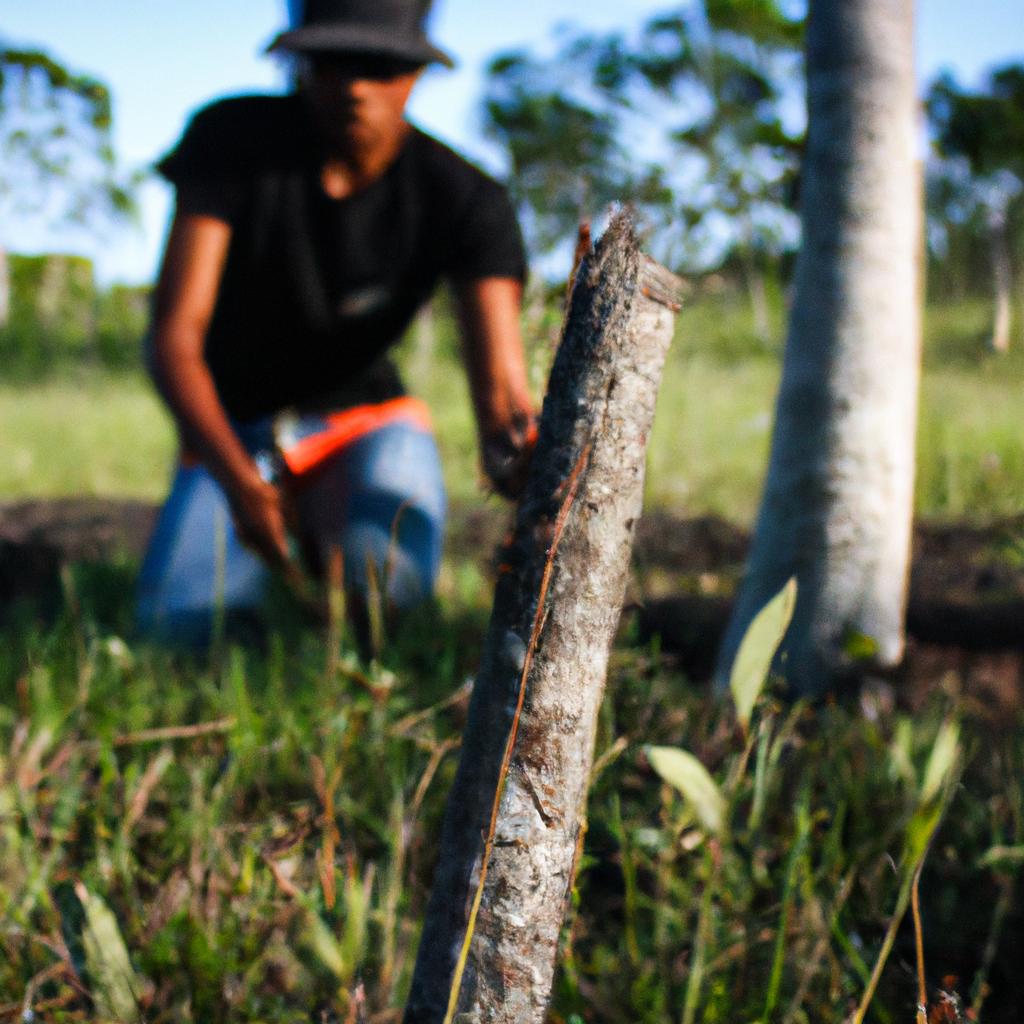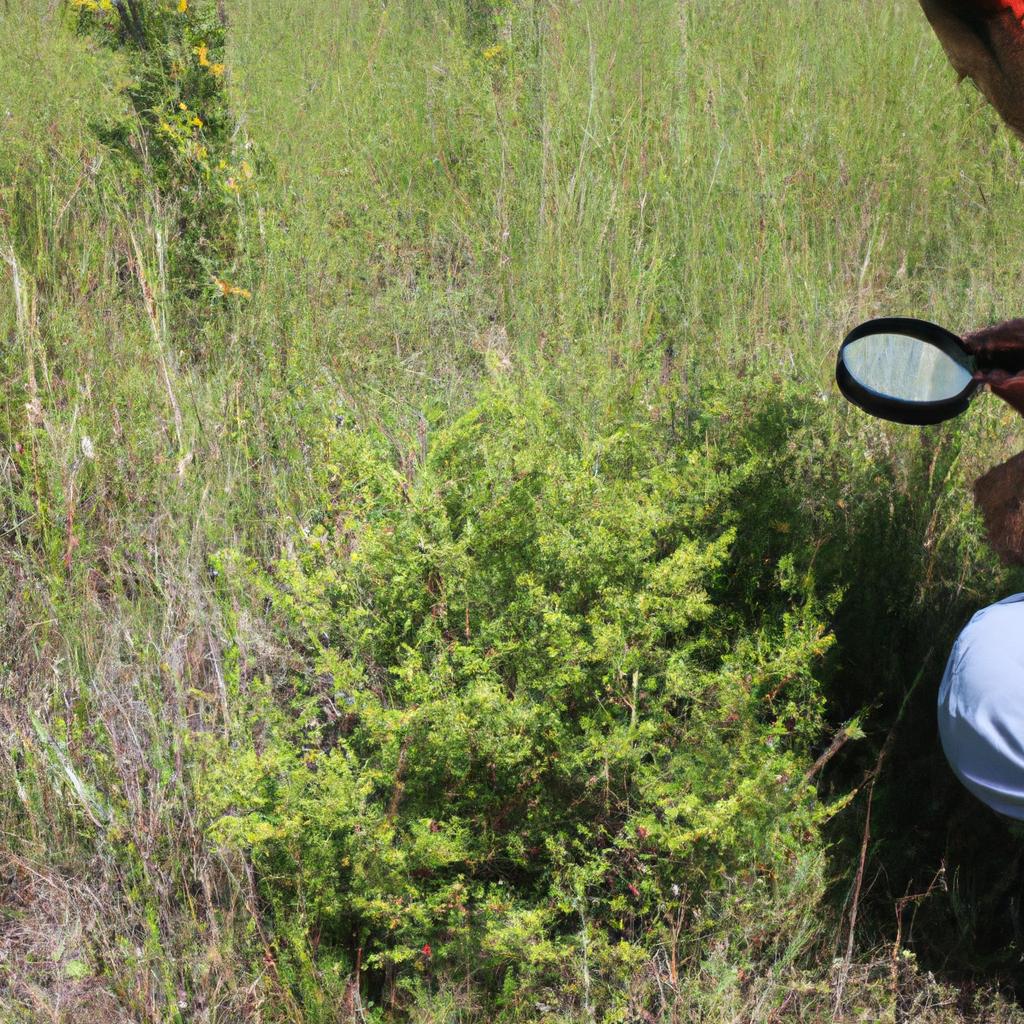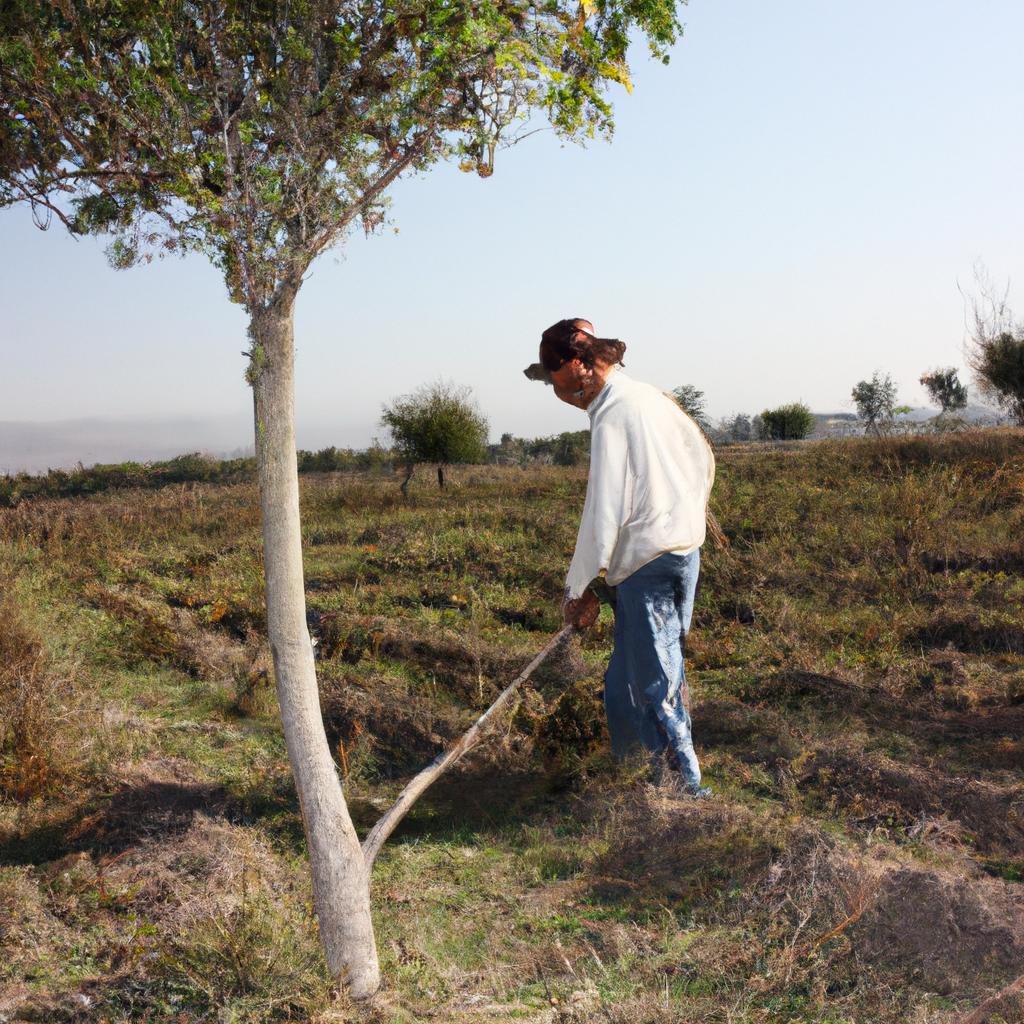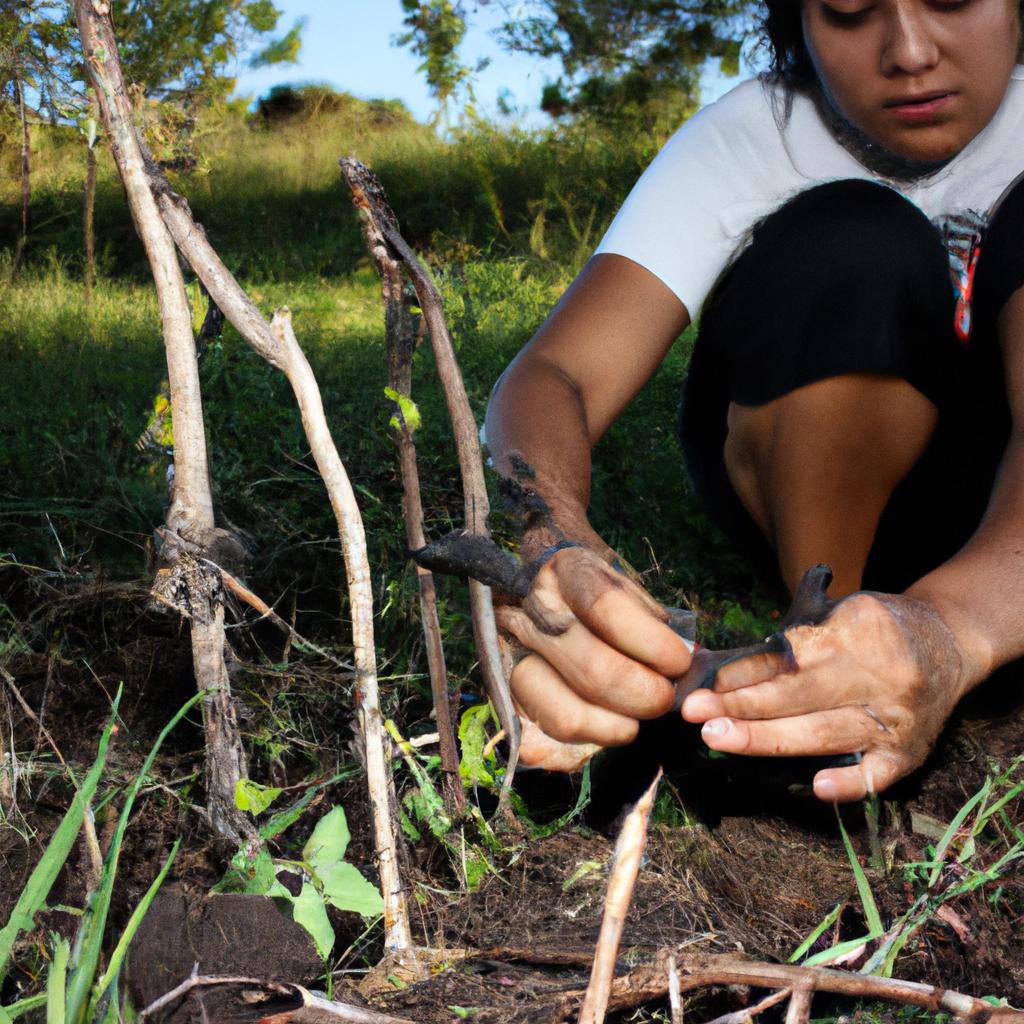Agroforestry techniques have emerged as a viable approach for enhancing both business agriculture and forestry practices. This article explores the various ways in which integrating trees with crops and livestock can lead to sustainable and profitable agricultural systems. By combining the principles of agroecology, silviculture, and land management, farmers and forest owners can optimize their production while simultaneously promoting environmental conservation.
To illustrate the potential benefits of agroforestry, let us consider a hypothetical case study of a coffee farmer in Central America. Traditionally, this farmer solely focused on cultivating coffee plants without considering other forms of vegetation or tree cover on the farm. However, by implementing an agroforestry system that incorporates shade trees alongside the coffee plants, the farmer effectively mitigates soil erosion and reduces water usage through improved water infiltration rates. Additionally, this integrated approach enhances biodiversity by providing habitat for wildlife species such as birds and insects. As a result, not only does the farmer witness increased productivity but also experiences long-term economic stability due to reduced input costs and market demand for sustainably produced coffee beans.
Overall, adopting agroforestry techniques offers tremendous potential for improving business agriculture and forestry practices. Through proper integration of trees within farming systems, farmers can achieve multiple benefits including enhanced soil health, increased water efficiency, improved biodiversity, and reduced input costs. By incorporating shade trees or windbreaks, agroforestry helps protect crops from extreme weather conditions and reduces the need for chemical inputs such as pesticides. The tree roots also help prevent soil erosion by holding the soil in place and improving its structure.
Moreover, agroforestry systems can provide additional sources of income for farmers. For example, they can harvest fruits or nuts from the trees alongside their main agricultural products. This diversification not only adds to their overall income but also provides a buffer against market fluctuations.
In terms of forestry practices, integrating trees with crops or livestock can lead to sustainable timber production. By carefully selecting tree species that have value as timber or fuelwood, forest owners can maximize their economic returns while promoting forest regeneration and conservation. Agroforestry systems also contribute to carbon sequestration and climate change mitigation by storing carbon in both vegetation and soils.
Overall, the adoption of agroforestry techniques presents an opportunity for farmers and forest owners to improve their livelihoods while preserving natural resources. Through thoughtful planning and management, they can create resilient agricultural systems that are economically profitable, socially beneficial, and environmentally sustainable.
Benefits of Combining Agriculture and Forestry
Agroforestry, the practice of integrating trees with agricultural crops or livestock on the same land, offers numerous benefits for both farmers and foresters. By combining agriculture and forestry, agroforestry systems can enhance business opportunities while promoting sustainable land management practices. One example that highlights these benefits is a case study conducted in rural Brazil where agroforestry techniques were employed to improve soil fertility and increase crop yields.
One significant benefit of agroforestry is its potential to enhance biodiversity and ecosystem services. Agroforestry systems provide habitat for various plant and animal species, including beneficial insects that contribute to natural pest control. Furthermore, the combination of different types of vegetation within an agroforestry system creates microclimates that support diverse ecological processes such as nutrient cycling and water filtration.
In addition to environmental advantages, agroforestry also has economic benefits. A markdown bullet point list effectively illustrates these advantages:
- Increased income diversification: Farmers who adopt agroforestry can generate revenue from multiple sources such as timber production, fruit harvesting, or livestock rearing.
- Reduced input costs: Agroforestry systems often require fewer synthetic inputs like fertilizers or pesticides due to improved soil health and enhanced biodiversity.
- Improved market access: The incorporation of tree products into agricultural activities enables farmers to tap into niche markets for specialty wood products or organic fruits.
- Climate resilience: Agroforestry provides a buffer against climate change impacts by reducing soil erosion, regulating temperature extremes, and enhancing water retention capacity.
To further demonstrate the practicality of agroforestry techniques, a three-column four-row table showcases the potential financial gains associated with specific combinations of crops and trees:
| Crop | Tree Species | Additional Income |
|---|---|---|
| Coffee | Shade Trees | Sale of shade-grown coffee beans |
| Corn | Fruit Trees | Sale of corn and fruit simultaneously |
| Livestock | Timber Trees | Revenue from timber sales + livestock products |
| Vegetables | Nut Trees | Harvesting vegetables and nuts together |
In summary, the integration of agriculture and forestry through agroforestry presents numerous benefits. By creating diverse ecosystems that support biodiversity, enhancing economic opportunities for farmers, and promoting climate resilience, agroforestry systems offer a sustainable pathway to improve both agricultural productivity and environmental stewardship. In the subsequent section on “Key Agroforestry Techniques for Maximizing Profitability,” we will explore specific strategies employed in successful agroforestry practices without disrupting existing farming operations.
Key Agroforestry Techniques for Maximizing Profitability
Combining agriculture and forestry through agroforestry techniques offers numerous benefits to both business owners in the agricultural sector and those involved in the forestry industry. This section will explore key agroforestry techniques that can be employed to maximize profitability, while also highlighting their advantages.
One example of an effective agroforestry technique is alley cropping, which involves planting rows of trees or shrubs alongside crops. This technique provides multiple benefits such as improved soil fertility, erosion control, and increased biodiversity. For instance, a case study conducted on a farm in Iowa showed that implementing alley cropping with hybrid poplar trees resulted in reduced soil erosion by 95% compared to traditional farming methods. Additionally, this practice contributed to higher crop yields due to enhanced nutrient cycling facilitated by tree roots.
- Increased long-term profitability
- Enhanced resilience against climate change impacts
- Promotes sustainable land management practices
- Supports local communities and rural development
Furthermore, another powerful tool within agroforestry is silvopasture – integrating trees into livestock grazing systems. By creating intentional grazing patterns among strategically planted trees, farmers benefit from improved animal welfare, reduced heat stress for livestock during hot weather conditions, increased carbon sequestration, and diversified income streams through timber production.
Let us now delve into the specifics of these agroforestry techniques through a three-column table:
| Agroforestry Technique | Benefits |
|---|---|
| Alley Cropping | – Improved soil fertility- Erosion control- Increased biodiversity |
| Silvopasture | – Improved animal welfare- Reduced heat stress- Carbon sequestration |
Transitioning smoothly towards the subsequent section about improving soil quality through agroforestry practices without explicitly stating “in conclusion,” it becomes evident that agroforestry techniques provide a promising avenue for enhancing business agriculture and forestry. The following section will explore how these practices contribute to improving soil quality, an essential aspect of sustainable land management in the agricultural sector.
Improving Soil Quality through Agroforestry Practices
Enhancing Soil Quality through Agroforestry Practices
To illustrate the benefits of agroforestry in improving soil quality and increasing agricultural productivity, let’s consider a hypothetical case study. Imagine a small-scale farmer named Maria who owns a plot of land that has been undergoing intensive conventional farming practices for several years. The soil on her farm has become depleted, resulting in decreased crop yields and increased vulnerability to erosion. Seeking a sustainable solution, Maria decides to implement agroforestry techniques on her land.
One key technique that Maria adopts is alley cropping, where she plants rows of trees or shrubs alongside her crops. This practice helps enhance the organic matter content in the soil by providing continuous leaf litter input from the trees, leading to improved nutrient cycling and moisture retention. Additionally, these trees help break up compacted soils with their deep root systems, allowing better water infiltration and reducing runoff.
In addition to alley cropping, Maria incorporates contour hedgerows into her agroforestry system. By planting hedges along the contours of her sloping fields, she effectively prevents soil erosion caused by rainfall-induced surface runoff. These hedgerows act as natural barriers, slowing down water flow and trapping sediments before they can be carried away by runoff. As a result, Maria’s soil remains intact and fertile while minimizing environmental degradation.
The adoption of agroforestry practices also allows Maria to diversify her income streams through multiple products obtained from various components within her system. Here are some potential benefits:
- Increased market opportunities: Agroforestry offers diverse produce such as fruits, nuts, timber, medicinal plants, honey and more.
- Improved resilience: By having multiple crops within an agroforestry system instead of relying solely on one commodity crop,
farmers like Maria reduce their vulnerability to market fluctuations or climate-related events affecting specific crops. - Enhanced ecosystem services: Trees provide shade and windbreaks for livestock or other sensitive crops, supporting biodiversity.
- Carbon sequestration: Agroforestry systems have the potential to capture and store significant amounts of carbon dioxide,
mitigating climate change impacts.
To further understand the advantages of agroforestry techniques, consider the following table:
| Benefits of Agroforestry Techniques |
|---|
| Increased soil organic matter |
| Reduced erosion |
| Diversified income streams |
| Enhanced ecosystem services |
As Maria continues to implement these agroforestry practices on her farm, she experiences noticeable improvements in soil quality and agricultural productivity. The case study highlights how adopting such techniques can offer a sustainable solution for farmers facing similar challenges.
Transitioning into the subsequent section about “Enhancing Biodiversity and Ecosystem Services in Agroforestry Systems,” it is essential to recognize that by improving soil quality through agroforestry practices, we also create an environment conducive to fostering diverse ecosystems within agricultural landscapes.
Enhancing Biodiversity and Ecosystem Services in Agroforestry Systems
In addition to improving soil quality, agroforestry practices also play a crucial role in enhancing biodiversity and providing various ecosystem services. By integrating trees into agricultural landscapes, farmers can create habitats for diverse plant and animal species, promoting ecological balance. For instance, let us consider the case of a small-scale farmer in South America who implemented agroforestry techniques on their land. They strategically planted fruit trees alongside their cash crops, creating a biodiverse environment that attracted pollinators such as bees and butterflies. This resulted in increased crop yields and improved overall farm productivity.
The benefits of agroforestry practices on biodiversity are manifold. Here are some key ways in which they contribute:
- Habitat creation: Trees provide nesting sites, shelter, and food sources for birds, insects, and other wildlife.
- Species diversification: The presence of different tree species within an agroforestry system enhances habitat diversity, supporting a wide range of organisms.
- Pollinator support: Flowering trees attract pollinators like bees and butterflies, aiding in the pollination of both crops and wild plants.
- Nutrient cycling: Tree roots improve nutrient availability through symbiotic associations with soil microorganisms.
To further emphasize the positive impact of agroforestry on biodiversity conservation, consider the following table highlighting specific examples:
| Ecosystem Service | Examples | Benefits |
|---|---|---|
| Pest control | Predatory birds controlling insect pests | Reduces reliance on pesticides |
| Carbon sequestration | Forests absorb carbon dioxide | Mitigates climate change impacts |
| Water regulation | Trees intercept rainfall | Prevents soil erosion |
| Soil fertility | Nitrogen-fixing leguminous trees | Enhances nutrient content |
As we can see from these examples, implementing agroforestry practices not only enhances biodiversity but also provides a range of valuable ecosystem services. This demonstrates the multifunctional nature of agroforestry systems, which can contribute to sustainable agricultural production while conserving and promoting ecological diversity.
Transition into the subsequent section about “Agroforestry as a Sustainable Solution for Climate Change Mitigation”: Given its numerous benefits in terms of soil quality improvement and biodiversity enhancement, it is evident that agroforestry has emerged as an effective strategy for addressing climate change. By integrating this approach into agricultural landscapes, farmers can actively contribute to climate change mitigation efforts while reaping economic and environmental rewards.
Agroforestry as a Sustainable Solution for Climate Change Mitigation
Enhancing Business Agriculture and Forestry through Agroforestry Techniques
Agroforestry, with its unique combination of agricultural crops and trees, offers a multitude of benefits that extend beyond enhanced biodiversity and ecosystem services. It presents an innovative approach to farming that can significantly enhance the profitability and sustainability of both agriculture and forestry sectors. To illustrate this potential, let us consider the case study of a small-scale farmer in rural Kenya.
In this hypothetical scenario, a farmer named Jane decides to implement agroforestry techniques on her land. She combines maize cultivation with fruit-bearing trees such as mangoes and avocados. This integrated system not only provides diversified income sources for Jane but also offers numerous advantages for her business agriculture and forestry practices.
Firstly, by incorporating trees into her farmland, Jane creates additional revenue streams from selling fruits alongside her main crop produce. This diversification minimizes the risk associated with relying solely on one type of crop, thus ensuring a more stable source of income throughout the year.
Secondly, the presence of trees within the agroforestry system improves soil health and fertility. The tree roots help prevent erosion while increasing organic matter content in the soil through leaf fall decomposition. Consequently, Jane experiences improved yields from her maize harvests due to increased nutrient availability in the soil.
Moreover, by adopting agroforestry techniques, Jane contributes to mitigating climate change through carbon sequestration. Trees act as effective carbon sinks, absorbing atmospheric CO2 emissions and storing them in their biomass. As a result, she indirectly reduces greenhouse gas emissions related to deforestation or conventional farming methods.
To further emphasize these benefits visually:
- Increased income stability
- Enhanced soil health
- Carbon sequestration
- Climate change mitigation
| Benefits | Visual Representation |
|---|---|
| Increased Income Stability |  |
| Enhanced Soil Health |  |
| Carbon Sequestration |  |
| Climate Change Mitigation |  |
By adopting agroforestry techniques, farmers like Jane can unlock the potential of their land to generate sustainable income while contributing positively to environmental conservation. As we delve into successful case studies of agroforestry implementation in the subsequent section, it becomes evident that this approach holds promise for transforming conventional agriculture and forestry practices towards a more resilient and profitable future.
Successful Case Studies of Agroforestry Implementation will demonstrate how various regions have effectively integrated agroforestry systems into their agricultural landscapes, showcasing the diverse benefits and outcomes achieved through these innovative approaches.
Successful Case Studies of Agroforestry Implementation
Transition from Previous Section:
Having explored the potential of agroforestry as a sustainable solution for climate change mitigation, it is essential to delve into successful case studies that demonstrate the practical implementation of these techniques. By examining real-world examples, we can gain valuable insights into the benefits and challenges associated with adopting agroforestry practices.
Successful Case Studies of Agroforestry Implementation
One notable example comes from the province of Misiones in Argentina, where small-scale farmers have successfully integrated agroforestry systems into their agricultural practices. These farmers combined traditional crops such as maize and soybeans with tree species like Eucalyptus grandis and Pinus taeda. The integration not only enhanced soil fertility but also provided additional sources of income through timber production.
To further illustrate the effectiveness of agroforestry, let us consider some key benefits derived from its implementation:
- Diversification: Agroforestry allows for diversifying farm enterprises by integrating different plant species, providing resilience against market fluctuations.
- Improved Soil Health: The combination of trees and crops promotes nutrient cycling, reduces erosion, and enhances soil structure, leading to long-term sustainability.
- Climate Change Mitigation: Agroforestry helps sequester carbon dioxide from the atmosphere, mitigating greenhouse gas emissions while simultaneously enhancing biodiversity.
- Economic Viability: Through multiple income streams generated by diverse products (e.g., fruits, nuts, timber), agroforestry contributes to increased economic stability on farms.
The following table showcases a comparison between conventional agriculture and agroforestry regarding various aspects:
| Aspect | Conventional Agriculture | Agroforestry |
|---|---|---|
| Biodiversity | Low | High |
| Carbon Sequestration | Minimal | Significant |
| Soil Erosion | High | Low |
| Income Generation | Single source | Multiple sources |
Through successful case studies and the comparison presented above, it is evident that agroforestry offers a promising solution for enhancing both business agriculture and forestry. By integrating trees into agricultural landscapes, farmers can achieve multiple benefits while contributing to sustainable development. This approach not only addresses climate change challenges but also promotes economic viability and environmental conservation.




